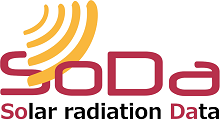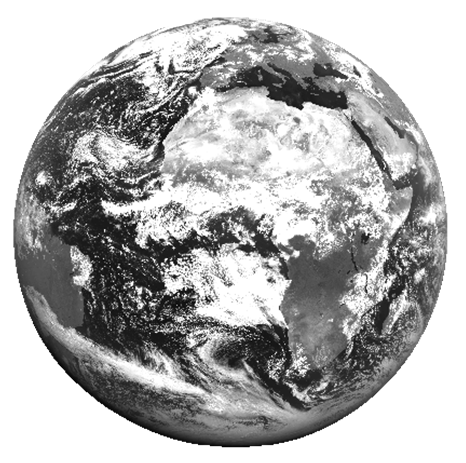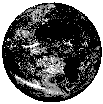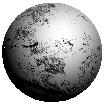Heliosat-2
Heliosat-2 |
Bibliography HelioClim-3/Heliosat-2
Heliosat-2 has been exploited to generate the HelioClim-1 database, and is launched in real time to generate HelioClim-3, our current database.
The Heliosat-2 method converts images acquired by meteorological geostationary satellites, such as Meteosat (Europe), GOES (USA) or GMS (Japan), into data and maps of solar radiation received at ground level. There is a wealth of publications on the various versions of the Heliosat-2 method. The original method is described in Cano et al. (1986), and the reference article is Rigollier et al. (2004) (see "publications" with the keyword "heliosat-2").
MINES ParisTech produced the method Heliosat-2 in November 2002, partly with the support of the European Commission (project SoDa, contract DG "INFSO" IST-1999-12245). More info and complete software (in C) and documentation are available for Heliosat-2.
Example of processing of Heliosat-2
|
Meteosat Second Generation raw image |
Derived cloud index (or "clearness index") |
Derived hourly irradiation |
Principle
Input images
The method has originally been designed to process broadband images, i.e. 0.4-1.1 µm. It was thus perfectly suited to the Visible (VIS) band (0.45 to 1.0 µm) of Meteosat First Generation, the channel exploited to generate HelioClim-1.
In the case of Meteosat second Generation (HelioClim-3), the High Resolution Visible (HRV - 0.4-1.1 µm) of the SEVIRI instrument doesn't cover the whole Meteosat disk. To generate HC3 on the whole Meteosat disk, we decided to process VIS0.6 (nominal spectral band: 0.56-0.71 µm) and VIS0.8 (0.74-0.88 µm) of Meteosat. The two images are merged into a synthetic image normalized according to the sensor and the sun elevation.
NB: The field of view is restricted to the pixels belonging to the Earth and for which an observer located on these pixels sees the satellite with an elevation angle above horizon larger than 12 degrees. This restriction generates missing values, in particular in winter time in the northern countries and reciprocally in summer time in the southern countries.
Principle: clear-sky model and cloud index
"Heliosat-2 combines a clear-sky model with a "cloud index". The cloud index approach is based on the assumption that the appearance of a cloud over a pixel results in an increase of reflectance in visible imagery; the attenuation of the downwelling shortwave irradiance by the atmosphere over a pixel is related to the magnitude of change between the reflectance that should be observed under a cloud-free sky and that currently observed. This magnitude of change is quantified by the cloud index.
HelioClim-3 version 4 (HC3v4) and version 5 (HC3v5) are the two most advanced versions of the HelioClim-3 database. HC3v4 uses the ESRA clear-sky model (Rigollier et al. 2000, Scharmer et al. 2000) with the climatological database of the Linke turbidity factor of Remund et al. (2003) as input. The major drawback of this database is that it is never updated to take into account changes in the atmosphere turbidity due to local effects such as maritime inputs, volcanoes, fires, evolution of the water vapor content, pollution…
The McClear clear sky model (Lefèvre et al. 2013) is an outcome of the European-funded MACC (Monitoring Atmospheric Composition & Climate - MACC-I, MACC-II and MACC-II) projects and is now operated by the CAMS (Copernicus Atmosphere Monitoring Service) projects. It takes as input updated information on the properties of the cloud-free atmosphere updated every 3 h and provides estimates of the Surface Solar Irradiance that should be observed if the sky were cloud-free for any site in the world since 2004. HC3v5 is an attempt to overcome the limitation of the climatological database of Remund et al. by combining HC3v4 and the McClear model (Qu et al. 2014)." extracted from Thomas et al. 2016
Bibliography HelioClim-3, Heliosat-2, ESRA, Tubidity Linke factor
(In alphabetic order and and reverse chronological order)
| Albarelo et al. 2015 | Albarelo T., I. Marie Joseph, A. Primerose, F. Seyler, L. Linguet, L. Wald, 2015. "Optimizing the Heliosat-II method for surface solar irradiation estimation with GOES images. Canadian Journal of Remote Sensing", 41, 86-100, 2015, doi: 10.1080/07038992.2015.1040876. | Heliosat-2 |
| Bauer 1996 | Bauer O., 1996. Les échanges océan-atmosphère dans l'Atlantique subtropical nord-est : apports de Meteosat. Thèse de Doctorat, Université de Nice - Sophia Antipolis, 162 p. | Heliosat |
| Beyer et al. 1997 | Beyer H.-G., Czeplak G., Terzenbach U., Wald L., 1997. "Assessment of the method used to construct clearness index maps for the new European solar radiation atlas (ESRA)". Solar Energy, 61, 6, 389-397. doi:10.1016/S0038-092X(97)00084-4 | ESRA (clear-sky model and Linke) |
| Beyer et al. 1996 | Beyer H.-G., Costanzo C., Heinemann D., 1996. "Modifications of the Heliosat procedure for irradiance estimates from satellite images". Solar Energy, 56, 3, p. 207-212. | Heliosat-2 |
| Blanc et al. 2011 | Blanc Ph., Gschwind B., Lefèvre M., Wald L., 2011. "The HelioClim project: Surface solar irradiance data for climate applications" Remote Sensing, 2011, 3, 343-361. doi:10.3390/rs3020343 | HelioClim in general |
| Cano et al. 1986 | Cano D., Monget J.-M., Albuisson M., Guillard H., Regas N., Wald L., 1986. "A method for the determination of the global solar radiation from meteorological satellites data" Solar Energy, 37, 1, 31-39. | Heliosat |
Content: In this publication, Cano et al. recommended to apply the Heliosat-2 method only for the slots when the sun is above 18° of elevation. We decided to slightly descrease this threshold to 12° in our implementation of Heliosat-2 (HelioClim-3).
| Cano 1982 | Cano D., 1982. "Etude de l'ennuagement par analyse de séquences d'images de satellite. Application à l'évaluation du rayonnement solaire global au sol" Thèse de Doctorat, Ecole nationale supérieure des télécommunications, Paris, France. | Heliosat |
| Cros et al. 2006 | Cros S., Albuisson M., Wald L., 2006. "Simulating Meteosat-7 broadband radiances at high temporal resolution using two visible channels of Meteosat-8". Solar Energy, 80, 3, 361-367, doi: 10.1016/j.solener.2005.01.012. | Heliosat-2 |
| Cros et al. 2004 | Cros S., Lefèvre M., Albuisson M., Wald L., 2004. "From meteorological satellite data to solar radiation climatological products: the HelioClim database". European Geophysical Union, 1st general assembly, Geophysical Research Abstracts, vol. 6, April 2004, EGU04-A-03853. | HelioClim |
| Cros 2004 | Cros S., 2004. "Création d'une climatologie du rayonnement solaire incident en ondes courtes à l'aide d'images satellitales (Design of an incident shortwave solar radiation climatology using satellite images)". Thèse de Doctorat en Energetique, Ecole des Mines de Paris, 13 septembre 2004, 157 pages. | HelioClim |
| Cros et al. 2004 | Cros S., Albuisson M., Lefèvre M., Rigollier C., Wald L., 2004. "HelioClim: a long-term database on solar radiation for Europe and Africa". In Proceedings of Eurosun 2004, published by PSE GmbH, Freiburg, Germany, pp. (3)916-920, ISBN 3-9809656-4-3. | HelioClim |
| Cros et al. 2004 | Cros S., Chriqi R., Albuisson M., Wald L., Dahman Saidi A., Bennouna M., 2004. "Integration of Meteosat-derived data and digital terrain model into a GIS for local atlases of solar radiation". European Geophysical Union, 1st general assembly, Geophysical Research Abstracts, vol. 6, April 2004, EGU04-A-06543. | HelioClim |
| Demarcq 1985 | Demarcq H., 1985. "Applications de la télédétection infrarouge et visible en océanographie. Etude de la zone de dilution rhodanienne, observation des zones de production dans le golfe du Lion, et estimation de l'éclairement solaire global en Méditerranée occidentale". Thèse 3ème Cycle, Univ. Aix-Marseille II. | Heliosat |
| Diabaté et al. 2004 | Diabate L., Blanc Ph., Wald L., 2004. "Solar radiation climate in Africa". Solar Energy, 76, 733-744. | ESRA |
| Diabaté et al. 2003 | Diabaté L., Remund J., Wald L., 2003. "Linke turbidity factors for several sites in Africa". Solar Energy, 75, 2, 111-119. | Linke turbidity factor |
| Diabaté et al. 1995 | Diabaté L., Wald L., 1995. "An attempt to estimate the diffuse component of solar radiation on horizontal plane from satellite images", African Journal of Science and Technology, 11, 1, 39-44. | Heliosat |
| Diabaté et al. 1989 | Diabaté L., Moussu G., Wald L., 1989. "Description of an operational tool for determining global solar radiation at ground using geostationary satellite images". Solar Energy, 42, 3, 201-207. | Heliosat |
| Diabaté 1989 | Diabaté L., 1989. "Détermination du rayonnement solaire à l'aide d'images satellitaires". Thèse de Doctorat en Sciences, Ecole des Mines de Paris, 272 p. | Heliosat |
| Diabaté et al. 1988 | Diabaté L., Demarcq H., Michaud-Regas N., Wald L., 1988. "Estimating incident solar radiation at the surface from images of the Earth transmitted by geostationary satellites : the Heliosat Project". International Journal of Solar Energy, 5, 261-278. | Heliosat |
| Espinar et al. 2012 | Espinar B., P. Blanc, L. Wald, B. Gschwind, L. Ménard, E. Wey, C. Thomas, L. Saboret, 2012. "HelioClim-3: a near-real time and long-term surface solar irradiance database". Workshop on Remote Sensing Measurements for Renewable Energy, May 2012, Risoe, Denmark. | HelioClim-3 v3 |
| Espinar et al. 2009 | Espinar, B., Ramírez, L., Polo, J., Zarzalejo, L.F., Wald, L., 2009. "Analysis of the influences of uncertainties in input variables on the outcomes of the Heliosat-2 method". Solar Energy, 83, 1731-1741, 2009, doi:10.1016/j.solener.2009.06.010. | Heliosat-2 |
| Geiger et al. 2002 | Geiger M., L. Diabaté, L. Ménard, L. Wald, 2002. "A Web service for controlling the quality of global solar irradiation" Solar Energy, Elsevier, vol. 73 (6), pp.475-480 | ESRA (Clear sky model and Linke), Quality check |
| Grüter et al. 1986 | Grüter W., Guillard H., Möser W., Monget J.-M., Palz W., Raschke E., Reinhardt R.E., Schwarzmann P., Wald L., 1986. "Determination of solar radiation at ground level from images of the earth transmitted by meteorological satellites, Solar Energy R&D in the European Community, Series F, vol. 4: Solar radiation data from satellite images", D. Reidel Publishing Co. for the Commission of the European Communities, 100 pp. | Heliosat (original) |
| Kasten 1996 | Kasten F., 1996. The Linke turbidity factor based on improved values of the integral Rayleigh optical thickness. Solar Energy, 56 (3), 239-244. | Linke Turbidity Factor |
| Lefèvre et al. 2004 | Lefèvre M., Cros S., Albuisson M., Wald L., 2004. "Developing a database using Meteosat data for the delivery of solar radiation assessments at ground level". In Proceedings of the 23rd EARSeL Annual Symposium "Remote Sensing in Transition", 2-4 June 2003, Ghent, Belgium, Rudi Goossens editor, Milpress, Rotterdam, Netherlands, pp. 485-489. | HelioClim |
| Lefèvre et al. 2002 | Lefèvre M., Rigollier C., Cros S., Wald L., 2002. "Toward a solar climatological database: the HelioClim project". In Proceedings of 22nd EARSeL Annual Symposium "Geoinformation for European-wide integration", 4-6 June 2002, Prague, Czech Republic. Tomas Benes editor, Millpress, Rotterdam, Netherlands, pp. 223-228. | HelioClim |
| Lefèvre et al. 2002 | Lefèvre M., Rigollier C., Cros S., Albuisson M., Wald L., 2002. "A shortwave radiation database to support GODAE-related activities". Proceedings of the International Symposium "En route to GODAE", 13-15 June 2002, Biarritz, France. Published by CNES, Toulouse, France, 2002, pp. 157-158. | HelioClim |
| Marie-Joseph et al. 2013 | Isabelle Marie-Joseph, Laurent Linguet, Marie-Line Gobinddass, Lucien Wald. "On the applicability of the Heliosat-2 method to assess surface solar irradiance in the Intertropical Convergence Zone, French Guiana". International Journal of Remote Sensing, Taylor & Francis, 2013, 34 (8), pp.3012-3027. <10.1080/01431161.2012.756598> | Heliosat-2 |
| Michaud-Regas 1986 | Michaud-Regas N., 1986. "Mise en oeuvre et validation d'une méthode opérationnelle et automatique pour l'évaluation d'atlas solaires en Europe à l'aide de mesures satellitaires Meteosat" Thèse de Doctorat, Univ. Paris VII, Paris, France. | Heliosat |
| Moussu 1988 | Moussu G., 1988. "Définition d'une méthodologie de détection de phénomènes dynamiques dans une chronique d'images, et son application à quelques études". Thèse de Doctorat en Sciences, Univ. Nice. | Heliosat |
| Obrecht 1990 | Obrecht D., 1990. "Météorologie solaire et images satellitaires : cartographie du rayonnement solaire, détermination de l'albédo des sols et évaluation de l'ennuagement", Thèse de Doctorat en Sciences, Univ. Nice. | Heliosat |
| Page et al. 2001 | Page J., Albuisson M., Wald L., 2001. "The European Solar Radiation Atlas: a valuable digital tool". Solar Energy, 71, 81-83, doi:10.1016/S0038-092X(00)00157-2 | ESRA (clear-sky model and Linke) |
| Qu et al. 2014 | Improving HelioClim-3 estimates of surface solar irradiance using the McClear clear-sky model and recent advances in atmosphere composition", Atmos. Meas. Tech., 7, 3927-3933, doi:10.5194/amt-7-3927-2014 (Creative Commons Attribution 3.0 License) | HelioClim-3 v3 + McClear |
| Qu 2013 |
Qu, Z.: Modeling radiative transfer in cloudy atmosphere to assess surface solar irradiance (in French), Ph.D thesis, MINES ParisTech, 202 p., 2013. |
Heliosat, HelioClim |
| Remund et al. 2003 | Remund J., Wald L., Lefèvre M., Ranchin T., Page J, 2003. "Worldwide Linke turbidity information", Proceedings of ISES Solar World Congress, 16-19 June 2003, Göteborg, Sweden. CD-ROM published by International Solar Energy Society. | Linke turbidity factor |
| Remund et al. 2003 | Remund J., Wald L., Page, J., 2003. "Chain of algorithms to calculate advanced radiation parameters". Proceedings of ISES Solar World Congress, 16-19 June 2003, Göteborg, Sweden. | HelioClim |
| Rigollier et al. 2004 | Rigollier C., M. Lefèvre, L. Wald, 2004. "The method Heliosat-2 for deriving shortwave solar radiation from satellite images", Solar Energy 77(2), pp. 159-169, 2004, doi 10.1016/j.solener.2004.04.017 |
Heliosat-2 |
| Rigollier et al. 2001 | The new method HELIOSAT-II. Report 1 to the European Commission, April 2001. (plus some figures in Word file). Report 2, June 2001. | Heliosat-2 |
| Rigollier et al. 2000 | Rigollier C, Bauer O, Wald L, 2000. "On the clear sky model of the 4th European Solar Radiation Atlas with respect to the Heliosat method", Solar Energy, 68, 1, 33-48. doi: 10.1016/S0038-092X(99)00055-9 | ESRA (clear-sky model and Linke) |
| Rigollier 2000 | Rigollier C, 2000. "Vers un accès à une climatologie du rayonnement solaire : estimation de l'irradiation globale à partir d'images satellitales", thèse de Doctorat en Sciences et Technologies de l'Information et de la Communication, Université Nice - Sophia Antipolis, 194 p. Heliosat-2 | Heliosat-2 |
| Wald et al. 2011 | Wald L., P. Blanc, B. Espinar, B. Gschwind, M. Lefevre, et al. 2011. "Early achievements towards an automatic assessment of the uncertainty in solar irradiation using web services", Pillmann W., Schade S., Smits P. 25th EnviroInfo Conference Environmental Informatics, Oct. 2011, Ispra, Italy. Shaker Verlag, Aachen, Germany, Vol. 1, pp.309-318 | HelioClim-3 |
Comment: Model for the estimation of lower and upper bounds when selecting standard HC3 outputs and horizontal plane orientation (escribed in section 4).
| Wald et al. 1992 | Wald L., Wald J.-L., Moussu G., 1992. "A technical note on a low-cost high-quality system for the acquisition and digital processing of images of WEFAX type provided by meteorological geostationary satellites", International Journal of Remote Sensing, 13, 5, 911-916. | Heliosat |



